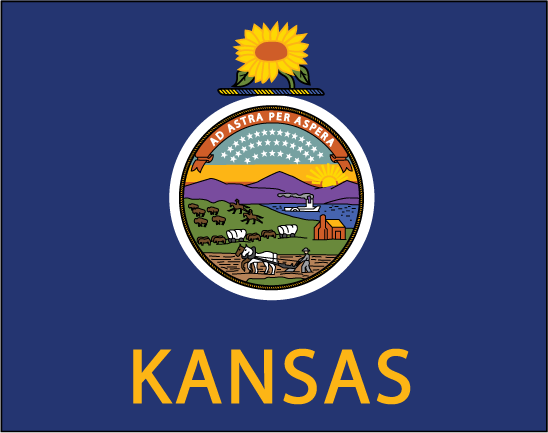Dr. Charles Robinson was the first Governor of the new State. He at once assembled the legislature and proceeded to inaugurate a State government: establishing courts, organizing additional counties and school systems, and providing for a program of general progress. Before anything could be accomplished, Kansas was called upon to participate in the great national conflict, the Civil War.
On April 15, 1861, President Lincoln issued a call for 75,000 volunteers. Kansas, only three months a State and still suffering from drought and the ravages of internal warfare, responded with 650 men. At the second call, two companies were organized with no promise of pay, since the new State had no money for military service. The total required of Kansas during the four years of war was 16,654 men. This was oversubscribed by more than 3,000, making a total of 20,097 constituting eighteen regiments, three of which were Indian and two Negro. The first regiment was mustered into service June 3, 1861; the last on July 28, 1864. The most important battle in which Kansas troops took part was that of August 10, 1861, at Wilson's Creek, south of Springfield, Missouri, where approximately 10,000 Confederates were engaged by 5,000 Union men under General Nathaniel Lyon. Lyon was killed, and the Unionists retreated with honor. The Eighth Kansas Volunteer Infantry, led by Colonel John A. Martin of Atchison (who later became the State's tenth Governor), after a year of border patrol service, joined the Army of the Cumberland and fought at Chickamaugua, in the Chattanooga campaign, and marched with Sherman to the sea. It was the only Kansas regiment attached to one of the major armies.
The Confederate force of General Sterling Price was the only one of the major armies to cross the Kansas border. In September 1864 General Price conducted the expedition known as "Price's Raid" through Arkansas and Missouri. He entered Kansas through Linn County in an apparent effort to reach Fort Scott, met the Unionists at Mine Creek and again at the crossing of the Osage. Here he was turned back into Missouri, after having caused damage to the extent of onehalf million dollars, later to be paid by the Government.
Though it was not in the zone of battle, the young State had its hands full with guerrilla warfare on its eastern border and Indian uprisings in the western part. Bands of bushwhackers led by William Clarke Quantrill, Bill Anderson, and others and the "Red Legs," so called from the red morocco leggings they wore, were continually active in burning, pillaging, and murdering. On August 21, 1863, Quantrill raided and sacked the town of Lawrence, slaying about 150 of its citizens. In the west the depredations of the Indians made organized resistance imperative.

